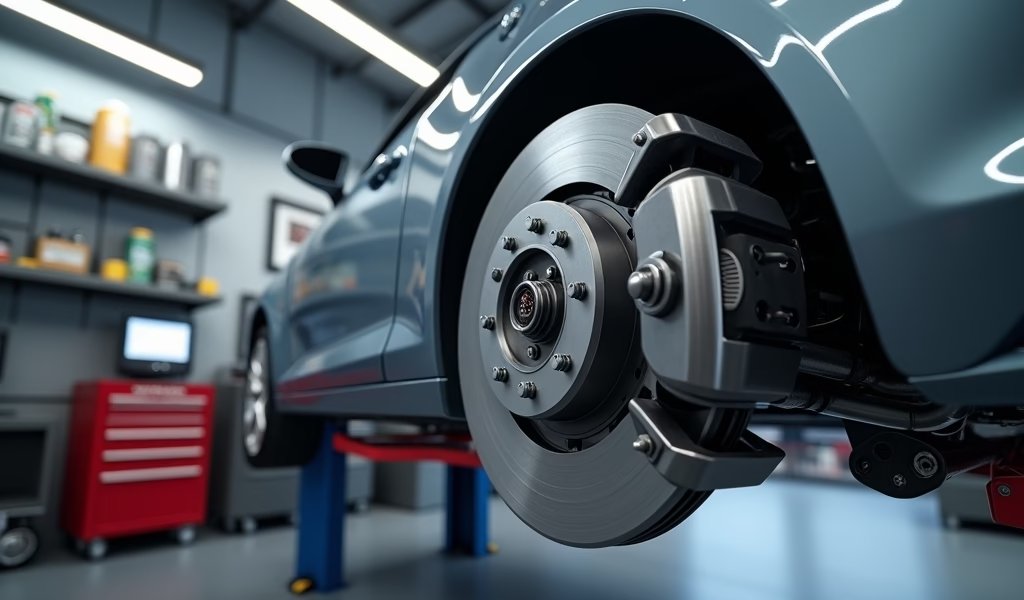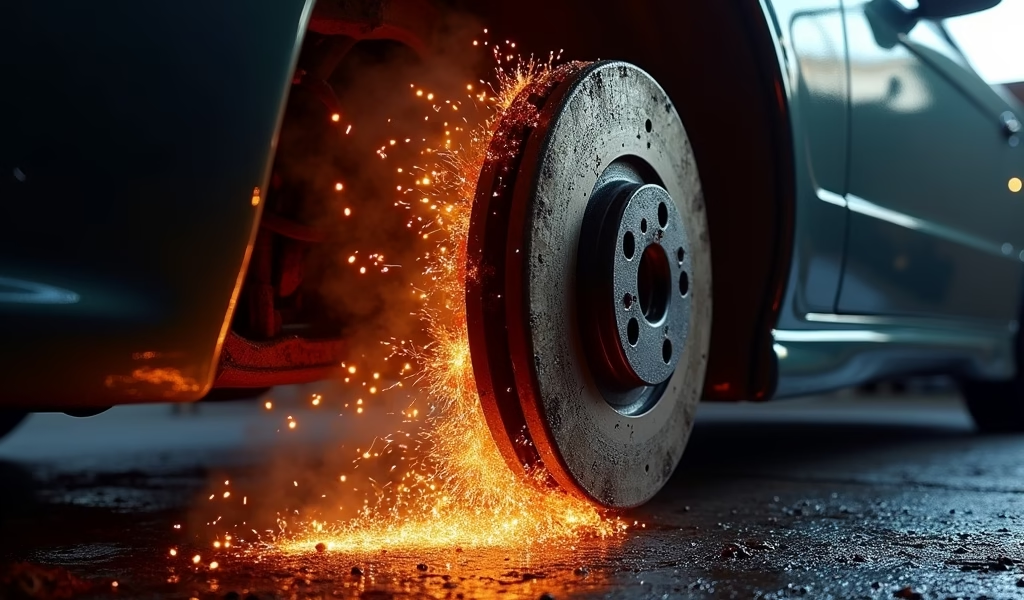Overview
This article outlines five essential brake maintenance strategies to ensure vehicle safety: recognizing warning signs, following regular inspection schedules, maintaining brake fluid, using quality parts, and finding trustworthy service providers. It emphasizes that proper brake maintenance isn’t merely a vehicle expense but a crucial investment in safety that can prevent accidents and costly repairs.
Table of Contents
- Introduction
- Recognize the Warning Signs
- Maintain a Regular Inspection Schedule
- Don’t Ignore the Brake Fluid
- Quality Parts Matter
- Find a Trustworthy Brake Service Provider
- Conclusion
- DIY Brake Maintenance Tasks
- Frequently Asked Questions
Introduction
Your vehicle’s braking system is the unsung hero of your daily commute—silently standing guard between you and potential disaster. Like a loyal sentinel, properly functioning brakes are your first and most critical line of defense on the road. Unfortunately, many drivers take this vital safety system for granted until it’s too late.
According to the National Highway Traffic Safety Administration, brake-related issues contribute to approximately 22% of vehicle crashes caused by mechanical failures. Even more sobering, a study by the Automotive Maintenance and Repair Association found that nearly 5% of vehicles on American roads have brake problems that would fail a safety inspection.
In this article, you’ll discover five proven tips to ensure your brakes remain in top condition, keeping you and your loved ones safe on every journey. We’ll explore warning signs, maintenance schedules, fluid considerations, parts quality, and how to find trustworthy service professionals. Your brake pedal shouldn’t feel like a prayer button—let’s make sure it’s a reliable safety mechanism you can count on.
Recognize the Warning Signs
Your brakes have a language of their own, and they’re not shy about communicating when something’s wrong. Learning to interpret these signals could be the difference between a simple brake repair and a roadside emergency.
Common Warning Sounds:
- High-pitched squealing (like fingernails on a chalkboard) often indicates worn brake pads
- Grinding or growling noises suggest metal-on-metal contact—brake pads have worn completely
- Clicking sounds might indicate loose components or hardware issues
Physical Warning Signs:
- A brake pedal that feels spongy or sinks to the floor (like stepping into quicksand)
- Vibration or pulsation when braking
- Vehicle pulling to one side during braking
- Burning smell after repeated hard stops
Remember, your brakes don’t suddenly fail without warning—they deteriorate gradually, often announcing their decline through these signals. Ignoring these warnings is like ignoring chest pain; by the time the situation becomes critical, you’re already in danger.
Look through your wheel spokes to examine brake pad thickness. If they appear less than ¼ inch thick, it’s time for replacement. Also, check underneath your vehicle for any dark puddles that could indicate leaking brake fluid.

Maintain a Regular Inspection Schedule
Prevention truly is better than cure when it comes to brake maintenance. Just as you wouldn’t skip your annual health checkup, your braking system deserves regular professional attention.
Most automotive experts recommend comprehensive brake service inspections every 12,000 miles or annually, whichever comes first. However, if you frequently drive in stop-and-go traffic, tow heavy loads, or navigate mountainous terrain, your brakes work overtime and may need more frequent attention.
During a professional inspection, technicians will typically:
- Measure brake pad thickness and rotor condition
- Test hydraulic system pressure and check for leaks
- Examine brake lines and hoses for damage
- Verify proper operation of the anti-lock braking system
- Check emergency brake functionality
The financial math is simple: a standard brake inspection costs $80-150, while complete brake failure can result in repairs exceeding $1,000—not to mention potential accident costs and the priceless value of personal safety. Viewed through this lens, regular inspections aren’t an expense; they’re an investment in your safety and financial well-being.
Don’t Ignore the Brake Fluid
Brake fluid is the lifeblood of your braking system, transforming the pressure from your foot into the force that stops your vehicle. Yet it’s often the most neglected component of brake maintenance.
Unlike motor oil, which visibly darkens when it needs changing, brake fluid deterioration happens invisibly. Over time, this hygroscopic fluid absorbs moisture from the air, compromising its effectiveness and potentially corroding internal components. When brake fluid becomes contaminated, it’s like trying to stop your car with watered-down coffee instead of proper hydraulic fluid.
Brake Fluid Maintenance Timeline:
- Check levels every 3 months
- Inspect color and clarity every 6 months (should be clear to amber, not dark brown)
- Replace completely every 2 years, regardless of mileage
Signs that your brake fluid needs immediate attention include:
- Fluid that appears dark brown or black
- Visible particles or contamination in the fluid
- Low fluid level in the reservoir
- Spongy or soft brake pedal feel
Remember: You can’t “top off” old brake fluid like you might with windshield washer fluid. The entire system needs proper bleeding and replacement to maintain safety, as recommended by car care experts.
Quality Parts Matter
When it comes time for brake replacement, the temptation to save money with budget parts can be strong. However, this is one area where cutting corners can cut safety margins too.
Think of brake components like parachutes—both are systems you want functioning at 100% when you need them most. The difference between premium and economy brake pads isn’t just about longevity; it’s about stopping power, noise levels, dust production, and reliability under extreme conditions.
Understanding Your Options:
1. OEM (Original Equipment Manufacturer) parts match what came on your vehicle from the factory. These provide consistent performance but often at premium prices.
2. Aftermarket parts vary dramatically in quality:
- Premium aftermarket brands (Akebono, Brembo, Wagner) often outperform OEM parts
- Mid-range options provide decent performance at moderate prices
- Economy options may wear quickly and perform poorly under stress
When evaluating brake pad quality, consider:
- The pad material (ceramic, semi-metallic, organic)
- Shim quality for noise reduction
- Inclusion of wear indicators
- Warranty coverage
While premium brake components might cost 30-50% more initially, they typically last 50-100% longer and provide superior performance throughout their lifespan. Factor in the reduced frequency of replacement and the safety benefits, and quality parts quickly pay for themselves.
Understanding the brake service cost breakdown can help you make informed decisions about where to invest in quality components.

Find a Trustworthy Brake Service Provider
Even the best brake components are only as good as their installation. Finding a reputable service provider is perhaps the most crucial step in maintaining your braking system.
A trustworthy brake specialist should be like a good doctor—diagnosing accurately, explaining options clearly, and never recommending unnecessary procedures. They should make you feel confident about your vehicle’s safety, not pressured into expensive repairs.
What to Look For:
- ASE (Automotive Service Excellence) certified technicians
- Specific experience with your vehicle make and model
- Transparent pricing with detailed estimates
- Willingness to show you the old parts and explain issues
- Clean, organized shop with modern equipment
Questions Worth Asking:
- “What brake pad material do you recommend for my driving style and why?”
- “How long should these repairs last under normal driving conditions?”
- “Do you offer a warranty on parts and labor?”
- “Can you show me what’s wrong with my current brakes?”
Red Flags to Watch For:
- Extremely low quotes that seem too good to be true
- Unwillingness to explain repairs in understandable terms
- Pressure tactics or scare strategies to upsell services
- No inspection of the vehicle before providing a quote
At Knows Your Car, we believe in educating customers first, then providing solutions. Our technicians take the time to show you exactly what needs attention and why, ensuring you never pay for unnecessary services.
For new customers, we’re currently offering 20% off brake service through June 2024. It’s our way of introducing you to service that prioritizes both safety and transparency.
Conclusion
Your vehicle’s braking system doesn’t just slow you down—it protects lives. These five tips form the foundation of brake safety:
- Listen to your brakes and heed their warnings
- Stick to a regular professional inspection schedule
- Maintain clean, effective brake fluid
- Invest in quality components when replacements are needed
- Partner with trustworthy service professionals
Brake maintenance isn’t just another item on your vehicle expense list—it’s an investment in your safety and peace of mind. When you press that pedal, confidence should be immediate and absolute.
Don’t wait until you hear that tell-tale squeal or feel that dangerous pedal fade. Schedule your comprehensive brake inspection today, and drive with the confidence that comes from knowing your stopping power is never in question.
Remember, at Knows Your Car, new customers receive 20% off complete brake services throughout June 2024. Our mission is to enhance both your vehicle’s performance and your ownership experience through technology-driven service solutions.
DIY Brake Maintenance Tasks
While major brake work should be left to professionals, several simple maintenance tasks can help you monitor your braking system between service appointments:
DIY Brake Checks You Can Perform:
- Visual inspection of brake pad thickness through wheel spokes
- Checking brake fluid level and color in the reservoir
- Listening for unusual sounds during braking
- Testing for pedal firmness and responsiveness
- Examining wheels for brake dust buildup patterns (significantly uneven dust can indicate problems)
Essential Tools for Basic Monitoring:
- Flashlight with flexible neck
- Tire pressure gauge (improper tire pressure affects braking)
- Clean white cloth for checking fluid clarity
- Jack and jack stands (for closer visual inspections)
Remember: While DIY checks help with early detection, professional service is essential for actual repairs. Brakes aren’t like changing a lightbulb—they’re complex safety systems where proper tools, techniques, and testing equipment make all the difference.
When your brakes speak up, listen carefully—and when they need attention, trust experts who value your safety as much as you do.
Frequently Asked Questions
How often should I get my brakes serviced?
Most vehicles should have brake inspections every 12,000 miles or annually. If you drive in challenging conditions or have a heavy-duty vehicle, consider more frequent checks.
What’s the average cost of a brake service?
A basic brake inspection typically costs $80-150, while a complete brake job can range from $250-$800 per axle. The price varies depending on your vehicle make, model, and the components needing replacement.
How long do brake pads typically last?
Brake pads generally last between 30,000 and 70,000 miles. Your driving style, vehicle weight, and pad quality all significantly impact pad lifespan.
What causes brakes to squeak?
Squeaking can be caused by worn brake pads (wear indicators making contact), glazed pads, or foreign particles caught between components. Some brake pads also naturally squeak when cold or damp.
Can I drive with grinding brakes?
No, grinding indicates metal-to-metal contact, meaning your brake pads are completely worn. Continuing to drive can damage rotors and other components, leading to brake failure and much higher repair costs.

